October 11, 2022

Are you breaking into the asphalt maintenance industry and need to know the ins and outs of working with asphalt paving? Perhaps you’re a seasoned pro in need of a quick refresher? Read on to learn more about asphalt repair processes.
Why exactly is asphalt the preferred option for driveway and parking lot paving? Firstly, it’s a completely recyclable material that limits adverse impacts on the environment. Secondly, it’s far more durable and reliable than other options, such as bricks.
Asphalt paving installation is more accessible, affordable, and efficient than concrete and masonry. When repairs are required, they’re often low in cost and simple to conduct. Lastly, asphalt is a soft material that helps reduce noise by absorption.
Professional pavers can conduct many varieties of asphalt paving processes with asphalt. These processes include patching, crack filling, seal coating, new installations, and overlaying. It’s important to note that seal coating doesn’t use asphalt but rather uses a seal-coating agent to protect the asphalt surface. Crack filling utilizes an adhesive compound that helps repair cracks and fractures in asphalt surfaces.
Patching is the process of repairing potholes. In general, patching fills damaged sections of a driveway or parking lot. For larger-scale projects, pavers conduct an overlay. This process helps slow down the development of cracks and potholes, but it isn’t a total fix. New installations are much more comprehensive processes—they’re long-term solutions to damaged driveways or parking lots. An installation includes demolishing the existing surface, grading and sloping, preparing the sublayer, adding a binder layer, and applying a new asphalt surface.
You’ll need a few types of equipment to work with asphalt. Mainly, you’ll use lutes, tampers, asphalt rakes, scoop shovels, and squeegees. These items help you control hot-mixed asphalt to ensure an even and level distribution. Additionally, you’ll need supplies like a tack coat, oil spot primer, and pothole patches. Equipment such as crack fillers, spray systems, and pour pots are essential for seal coating and crack filling.
Use this quick guide on working with asphalt paving to ensure your clients are absolutely satisfied with your services. Stock up on all the essential asphalt repair products here at Nac Supply—our friendly team can help you find the perfect items for your specific needs.
Comments will be approved before showing up.
October 08, 2025
October 02, 2025
Asphalt crack repairs can be a meticulous process. One step you don’t want to skip is routing, as this provides many benefits to sealed cracks.
September 23, 2025